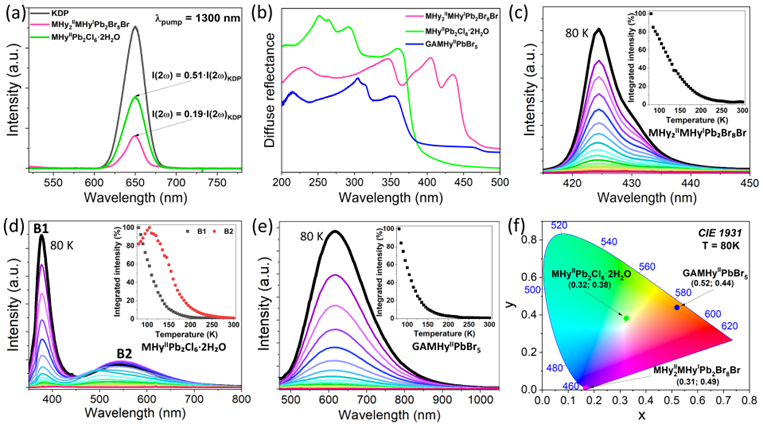Divalent Methylhydrazinium – an Ultrasmall Organic Cation for Construction of Hybrid Perovskites
Title: Divalent Methylhydrazinium – an Ultrasmall Organic Cation for Construction of Hybrid Perovskites
Authors: M. Mączka, A. Gagor, D. Stefanska, J. Hanuza, E. Kucharska, J.K. Zaręba
Journal: Chemistry of Materials
DOI: 10.1021/acs.chemmater.5c00919
The duality of protonation states in amines is very rare and has been reported for guanidinium and hydrazinium only, which typically exist as monocations (GA⁺ and Hy+) but can be di-protonated to GA²⁺ and Hy2+ under superacidic conditions. In their recent article, prof. Mączka’s group discovered the third amine possessing such properties, as evidenced by synthesis of two simple salts containing di-protonated methylhydrazine (MHy2+). More importantly, methylhydrazine has also been identified as an organic amine capable of existing in both mono- (MHy+) and di-protonated (MHy2+) forms within hybrid organic-inorganic perovskite frameworks, a feature previously unreported for this class of materials. This dual protonation capacity enables the construction of mixed-cation systems, as exemplified by MHy₂IIMHyIPb₂Br₈Br, where MHy²⁺ and MHy⁺ coexist in a polar Dion–Jacobson-type structure. The purely MHy²⁺-based halides MHyIIPb₂Cl₆·2H₂O and GAMHyIIPbBr₅ demonstrate how this cation can stabilize frameworks of varying dimensionality from polar 2D slabs of face- and edge-sharing PbCl₇ and PbCl₈O polyhedra to centrosymmetric 1D chains of PbBr₆ octahedra. The performed studies revealed that the di-protonation of MHy has severe structural consequences. In particular, MHy²⁺ cation prevents the formation of 3D frameworks, Pb-N coordination bonds and disordered phases. Photoluminescence studies revealed that these materials exhibit emission ranging from purplish blue to orange-yellow and warm white. Importantly, two of the three reported lead halides exhibit strong SHG responses, with MHyIIPb₂Cl₆·2H₂O showing an SHG signal nearly three times greater than that of any known MHy⁺-based hybrid perovskite.
Overall, these findings establish methylhydrazinium as an ultrasmall cation with a possible divalent state for hybrid perovskites with a tailored symmetry and functionality. By leveraging dual protonation states, this work opens pathways for engineering nonlinear optical materials, efficient light emitters, and multifunctional systems with polar order.

Highlights:
- Dual protonation states have been discovered for MHy
- Novel hybrid perovskites comprising MHy2+ have been synthesized
- These compounds exhibit narrow and broadband photoluminescence
- • Two compounds demonstrate efficient SHG activity


